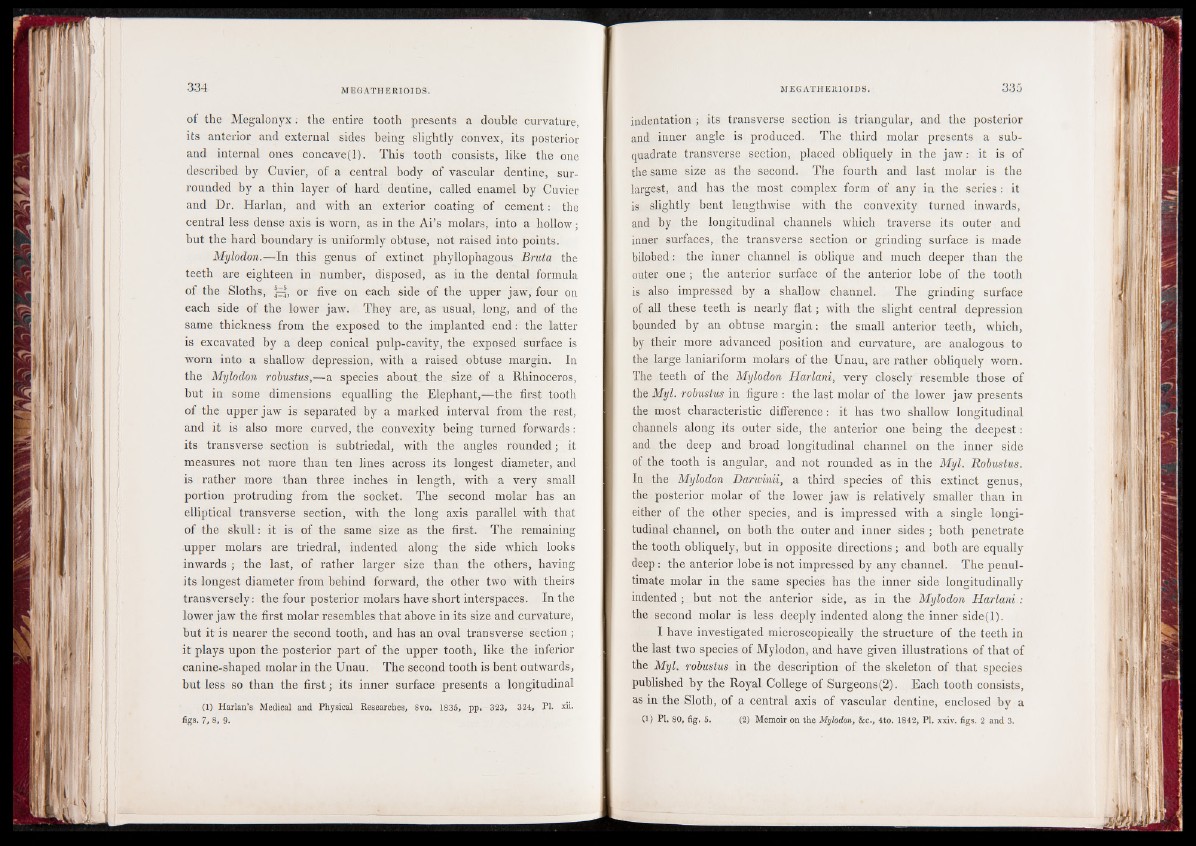
of the Megalonyx: the entire tooth presents a double curvature,
its anterior and external sides being slightly convex, its posterior
and internal ones concave(l). This tooth consists, like the one
described by Cuvier, of a central body of vascular dentine, surrounded
by a thin layer of hard dentine, called enamel by Cuvier
and Dr. Harlan, and with an exterior coating of cement: the
central less dense axis is worn, as in the Ai’s molars, into a hollow;
but the hard boundary is uniformly obtuse, not raised into points.
Mylodon.—In this genus of extinct phyllophagous Bruta the
teeth are eighteen in number, disposed, as in the dental formula
of the Sloths, 4=3, or five on each side of the upper jaw, four on
each side of the lower jaw. They are, as usual, long, and of the
same thickness from the exposed to the implanted end: the latter
is excavated by a deep conical pulp-cavity, the exposed surface is
worn into a shallow depression, with a raised obtuse margin. In
the Mylodon robustus,—a species about the size of a Rhinoceros,
but in some dimensions equalling the Elephant,—the first tooth
of the upper jaw is separated by a marked interval from the rest,
and it is also more curved, the convexity being turned forwards:
its transverse section is subtriedal, with the angles rounded; it
measures not more than ten lines across its longest diameter, and
is rather more than three inches in length, with a very small
portion protruding from the socket. The second molar has an
elliptical transverse section, with the long axis parallel with that
of the skull: it is of the same size as the first. The remaining
-upper molars are triedral, indented along the side which looks
inwards ; the last, of rather larger size than the others, having
its longest diameter from behind forward, the other two with theirs
transversely: the four posterior molars have short interspaces. In the
lower jaw the first molar resembles that above in its size and curvature,
but it is nearer the second tooth, and has an oval transverse section ;
it plays upon the posterior part of the upper tooth, like the inferior
canine-shaped molar in the Unau. The second tooth is bent outwards,
but less so than the first; its inner surface presents a longitudinal
(1) Harlan’s Medical and Physical Researches, Svo. 1835, pp, 323, 324, PI. xii.
figs. 7, 8, 9.
indentation ; its transverse section is triangular, and the posterior
and inner angle is produced. The third molar presents a subquadrate
transverse section, placed obliquely in the jaw : it is of
the same size as the second. The fourth and last molar is the
largest, and has the most complex form of any in the series : it
is slightly bent lengthwise with the convexity turned inwards,
and by the longitudinal channels which traverse its outer and
inner surfaces, the transverse section or grinding surface is made
bilobed: the inner channel is oblique and much deeper than the
outer one ; the anterior surface of the anterior lobe of the tooth
is also impressed by a shallow channel. The grinding surface
of all these teeth is nearly flat; with the slight central depression
bounded by an obtuse margin: the small anterior teeth, which,
by their more advanced position and curvature, are analogous to
the large laniariform molars of the Unau, are rather obliquely worn.
The teeth of the Mylodon Harlani, very closely resemble those of
the Myl. robustus in figure : the last molar of the lower jaw presents
the most characteristic difference: it has two shallow longitudinal
channels along its outer side, the anterior one being the deepest:
and the deep and broad longitudinal channel on the inner side
of the tooth is angular, and not rounded as in the Myl. Robustus.
In the Mylodon Darwinii, a third species of this extinct genus,
the posterior molar of the lower jaw is relatively smaller than in
either of the other species, and is impressed with a single longitudinal
channel, on both the outer and inner sides ; both penetrate
the tooth obliquely, but in opposite directions ; and both are equally
deep : the anterior lobe is not impressed by any channel. The penultimate
molar in the same species has the inner side longitudinally
indented; but not the anterior side, as in the Mylodon Harlani :
the second molar is less deeply indented along the inner side(l).
I have investigated microscopically the structure of the teeth in
the last two species of Mylodon, and have given illustrations of that of
the Myl. robustus in the description of the skeleton of that species
published by the Royal College of Surgeons(2). Each tooth consists,
as in the Sloth, of a central axis of vascular dentine, enclosed by a
(1) PI. 80, fig, 5. (2) Memoir on the Mylodon, &c., 4to. 1842, PI. xxiv. figs. 2 and 3.